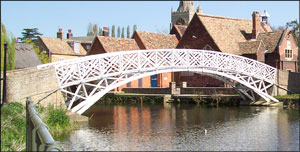
The Chinese Bridge is a landmark of our town and has stood since 1827. The bridge is now in its forth generation. Originally designed and constructed by an Irish Architect 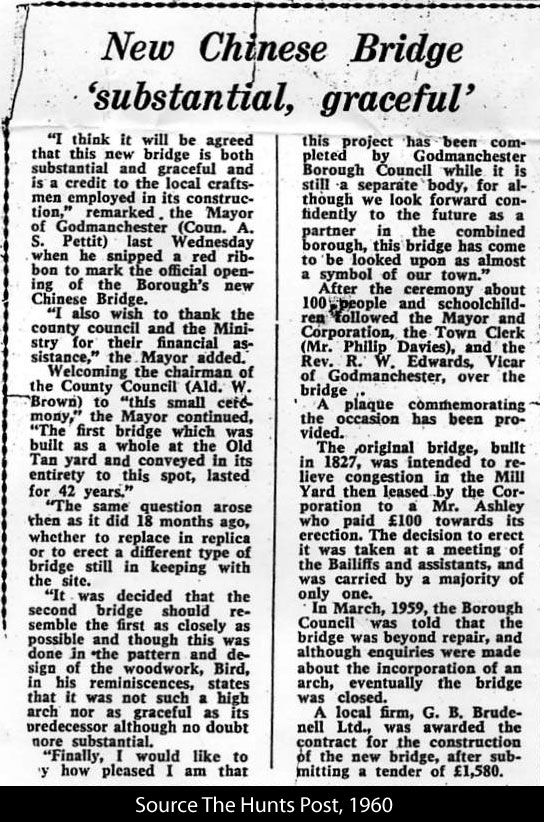 by the name of James Gallier, rebuilt in the 1860s and again rebuilt in 1960 with a replica by G.B. Brudenall Ltd of Godmanchester for the sum of £1,580, on behalf of the council (Select the image on the right for the newspaper article) and again replaced with a replica 50 years later by CTS Bridges, Shepley, Huddersfield.
by the name of James Gallier, rebuilt in the 1860s and again rebuilt in 1960 with a replica by G.B. Brudenall Ltd of Godmanchester for the sum of £1,580, on behalf of the council (Select the image on the right for the newspaper article) and again replaced with a replica 50 years later by CTS Bridges, Shepley, Huddersfield.
The design of the bridge was influenced by the popular 18th Century style on Chinoiserie, a French term, indicating “Chinese-esque” which was a recurring theme throughout Europe and is a mixture of Eastern and Western styles for both decoration and shape.
The original Architect Gallier, did not come to Godmanchester for the sole purpose of designing and erecting the Chinese Bridge. He was originally commissioned to be “Clark of the Works" and oversee the construction of Huntingdon’s Prison, which can still be found at St-Peters road today. From Galliers’ autobiography he describes his time in Huntingdon and Godmanchester with joy and great sadness. The following is a quote from his autobiography:
|
“In 1826 I was flavoured a letter from Mr. Wilkins saying that, if I still had a desire to be engaged as a clerk of the works, he had something which might suit me; and if I could meet him in the town of Huntingdon, he could there point out the duties I should have to perform if I entered into the engagement. I attended at the appointed time and place, and found he was about to build a prison for the county of Huntingdon.
Having examined into my fitness for the situation, he engaged me at a salary of four pounds a week, to take charge of the plans, and to see that the work was performed by the contractor in accordance with the drawings and specification.
I was delighted with my new situation, being the first appointment I ever had that held out a prospect of advancing my position in life; so, having returned to London and put my affairs in order, I took my family down to Huntingdon and soon had everything put into proper working condition.
In a year after my marriage our first child was born, which was a boy, but he died early in infancy; our second was a girl, who lived to the age of four years our third was my dear James, the only one left now; he was born in Huntingdon on the 25th September, 1827, and was Christened in the picturesque old church of that town; our forth was a girl, born after our return to London, but died in early childhood.
My next neighbour at Huntingdon was Mr. Robert Carruthers, a literary man, who carried on the business of a book binder at the same time with the management of the county school. He published a history of Huntingdon and other works; and, having afterwards removed to Scotland, became editor and ultimately the proprietor of the “Inverness Courier” which he conducted with great ability for many years. This excellent man was of much service to me, he directed me to a course on reading and put me in the way of obtaining books. I became a member of a debating society and a social book club; I also joined a Masonic lodge, and, during my two years of my stay at Huntingdon, my knowledge of life and the ways of Society became much enlarged.
I made a small wooden model of the gaol, so constructed that the roofs and upper storeys could be separately lifted up to show the interior divisions of all the yards , passages, rooms, and cells throughout the building this I sent to Mr. Wilkins, who was highly pleased with it.
I was frequently called on by persons of the town and neighbourhood of Huntingdon to give plans for alterations to their houses; I also planned and superintended the erection of a small wooden bridge, of original deign, across a branch of the River Ouse at Godmanchester, and I now began to fancy myself a person of some little importance. To understand the degree of elation I at that time felt, a man must have started in life as I had done, on nearly the lowest rung of the social ladder, and have toiled his way painfully upward, even to the humble position I had then attained." |
After completing his work in Huntingdon James Gallier returned to London and started work on the redevelopment of the Grosvenor Estate in Mayfair. Unfortunately Gallier became bankrupt and emigrated to America in 1832 with his family. Gallier had a successful career in America, his noteable achievements, which are now National Historic Landmarks include Gallier Hall, Pontalba Buildings, Government Street Presbyterian Church, the Leeds Davies Building, The Second Christ Church Catherdral, Barton Academy and Belle Helene.
James Gallier died on October 1866 during a trip on the steamer Evening Star, from New York to New Orleans which sank during a Hurricain. His second wife, Catherine Robinson died with him.
To record the replacement of the Chinese Bridge in 2010, the Porch Museum decided to record the removal and replacement of the bridge. These few days filming have now been put together into a historical DVD. The film also contains interviews and new details on James Gallier from Godmanchesters best liked historian Ken Sneath. We further investigate Godmanchesters second bridge linking Island Hall with its Island, the story is told by Christopher Vane Percy.
To purchase this DVD please visit the Godmanchester Porch Museum Shop for further information.
The following links are extracts from the DVD showing interviews with David Brown and Christopher Vane Percy.
Click the image below for a short gallery of Chinese Bridge Photos
My name is Christopher Vane Percy I'm the seventh generation of my family to live in this house which was built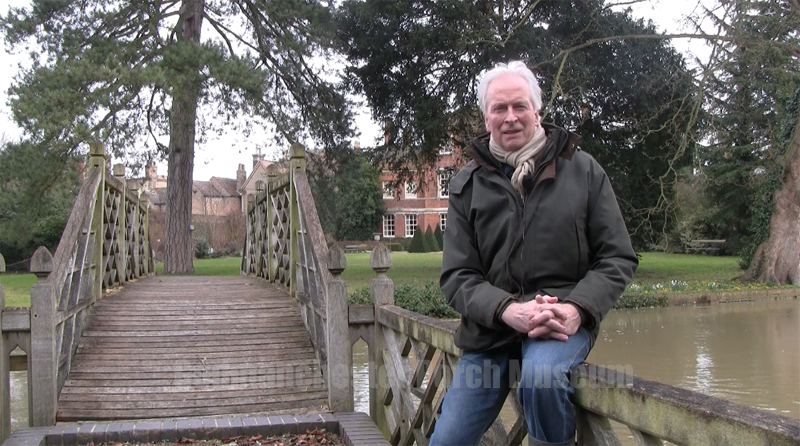 Christopher Vane Percy in the middle of the 18th Century by John Jackson the receiver of the land taxes. He put up this ornamental Chinese Bridge to link the garden with the island in the river from which the house takes its name.
Christopher Vane Percy in the middle of the 18th Century by John Jackson the receiver of the land taxes. He put up this ornamental Chinese Bridge to link the garden with the island in the river from which the house takes its name.
In the middle of the 17th century Britain and northern Europe were gripped with China mania, this was due to the improved trade conditions with the far east and during the middle of the 18th century the rococo style which came into fashion was very much synonymous with Chinese Chippendale of which this bridge is a good sample of the style.
By the end of the 18th century the neo classical style had taken over and the Chinese taste had faded. But in the first half of the 19th century the prince regent flying against fashion, reinvented the Chinese style which can be seen in buildings like the Chinese pavilion, the Royal pavilion in Brighton. By the time we get to the 1820s, the style was already beginning to go out of fashion again, but it was decided by the Godmanchester town that they would like to have a Chinese bridge again while the style was fading.
The bridge here at Island Hall has been described in the 1800s as a pretty Chinese bridge. It was described again by Octavia Hill in the middle of the 19th century and towards the end of the 19th century it was altered to allow the horse drawn lawn mower to be pulled over by the Donkey.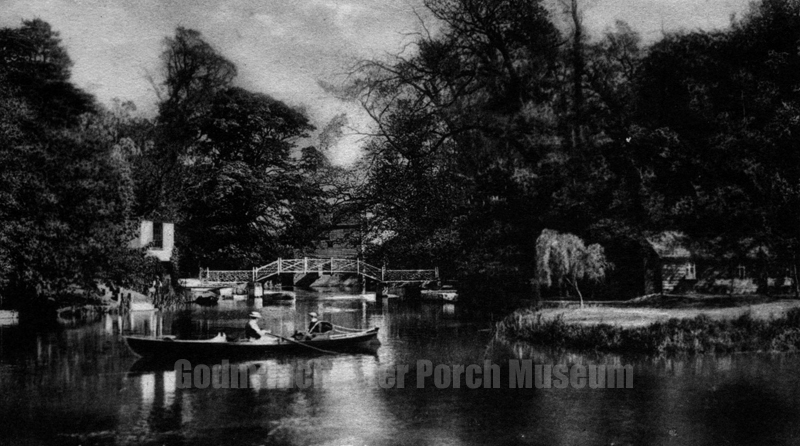 Island Hall Chinese Bridge
Island Hall Chinese Bridge
In the 1920s one of the Huntingdon Elms fell through the bridge on a night of a particularly fierce storm. The bridge with its elegant camber was destroyed. It was bolted back together again and this is the bridge I remember as a child. The bridge was finally winched into the river in the early 60s and in the mid 80s we started this new project to reconstruct a replica of John Jackson's bridge.
The bridge which has won an award for the craftsmanship award which was given by the Cambridge Architectural Association was obviously a feather in our cap. We also won the environmental trophy from the district council and it has restored to Godmanchester one of its more picturesque views
| Hello my names Danny Ward and I'm working on behalf of Atkins and we're here to tell you about the Chinese Bridge being removed.
It's a very special job we've, we found it very exciting, I think all the crew here have been fantastic especially the crane driver when they managed to lift the bridge out in one piece. It's a very unusual job we dont get many of these so its been very interesting. Interviewer "Can I ask you about the chain saws and what happened with them?" |
|
What it was we didn't take into account there would be a steal plate underneath the bridge so the chain saws obviously couldn't cut all the way through the wood, so we had to go back and get a steal saw to cut through the steel plates on the bottom and as you could see the chain saws got blunted by one of the blades so we had to renew the blades on it.
|
| Interviewer "And the crane coming in, is that a 300 tonner?"
I'm not sure how big the crane whats coming in is, I know we had to have the 300 Tonne crane for the lift out because they was worried about the rotten underneath of the bridge and it falling apart on lifting. I think the Slingers and the Banksman done a fantastic job because they managed to sling it at 8 points and managed to keep it in one piece which was fantastic. The crane driver was absolutely immense he was very smooth and he managed to keep things very sturdy whilst going through. |
|
Hello I'd like to introduce myself as David Brown the Mayor of Godmanchester. You're joining us on a late February day on 2010 where we are going to witness the replacement of the iconic Godmanchester Bridge that we've enjoyed since its design in 1827 by a chap called James Gallier an Irishman who at the young age of 29 designed this and this is going to be the current replacement and hope much valued addition to preserving Godmanchester town scene. Having lived in the town for 16 years now, my wife and I have always associated Godmanchester with this bridge and as you can see behind me we have the first half |
| that's going to be floated on some pontoons and temporarily suspended by a crane this evening to be followed up tomorrow by the second half which will mate on the Town Hall side, which will link in the main town with the recreation centre. |
| We are very proud to be able to benefit from the financial contribution that Highways and District Council have committed to support this feature, we are very proud of it and its all in keeping with the kind of architecture that was the form in early 19th Century.
I know that a lot of people have a very romantic association with this bridge they feel that there is no other thing other that perhaps St-Marys church that signifies the character and tranquility of the town. So we hope that you enjoy this limited edition and will gain some kind of tangible connection with the history of Godmanchester. |
My name is Ken Sneath, I've been a resident here in Godmanchester for 28 years and I've been researching the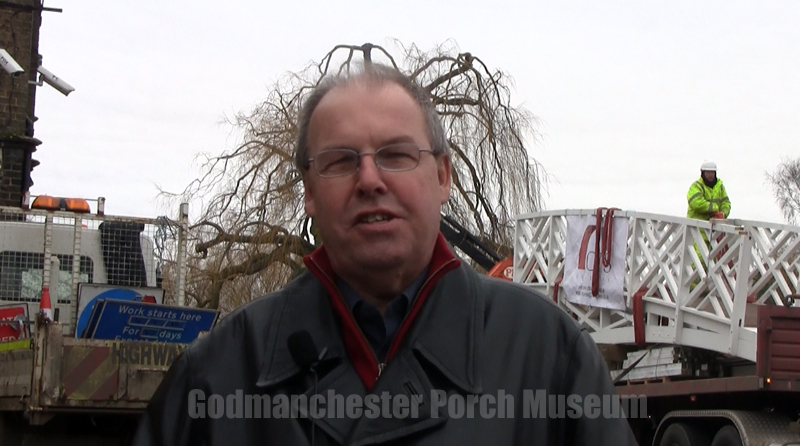 history of the town for some years in preperation for a book which is being produced to celebrate the 2012 anniversary of the charter. history of the town for some years in preperation for a book which is being produced to celebrate the 2012 anniversary of the charter.Today the new Chinese Bridge is being erected, it is very much an iconic image of Godmanchester and perhaps some people might be disappointed to see that the old bridge has been taken down and replaced by a new one. But of course the bridge which has been taken down is not the original bridge we have in fact two Chinese Bridges in Godmanchester. One links Island Hall with its island and the other one is our town bridge. |
| You may well ask why do we have two Chinese Bridges in Godmanchester? Well there was a great fashion for something known as chinwazary in the 18th Century and it came somewhat to a peak in the mid 18th century and shortly afterwards the Island Hall bridge was built. As i said this links Island Hall with its island, unfortunately a great storm happened in 1928 and an Elm fell down on the bridge crushing it and it was replaced by a replica in 1988 by Christopher Vane-Percy the present owner of Island Hall and he won a number of awards for that replica bridge. 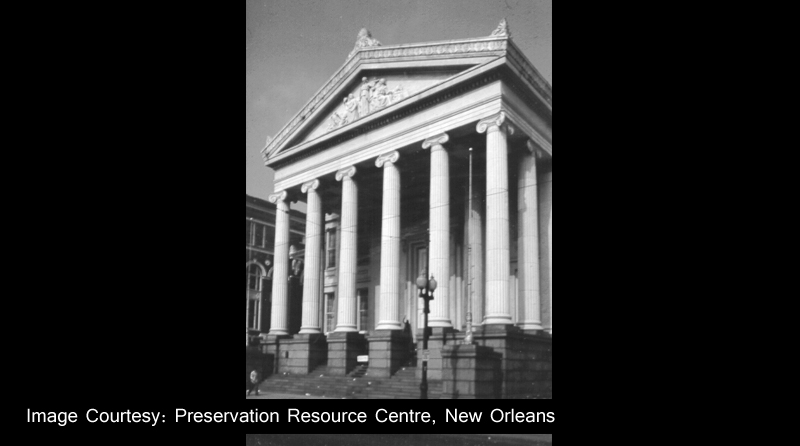 But turning to our town bridge that was designed in 1827 by an Irish architect by the name of James Gallier. Now James Gallier has a somewhat interesting history. The town bridge was one of his first commissions as a young man just under the age of 30, he went on to work on the Grosvenor estate in London and then unfortunately went bankrupt and went of to America where he became in the end a quiet notable architect.His most famous building was the City Hall in New Orleans which has got wonderful columns and ionic capitals to those columns. He was no stranger to adversity and James Galliers first wife died but after having produced a son, who was also called James who became and architect, but James married again and his second wife was called Caroline. Later in life as they were sailing down the east coast of the United States, their ship sank just of Cape Hatteras in Carolina and both he and his second wife were drowned. So quiet an interesting man this Irish architech who designed the new, the town bridge for Godmanchester which is being replaced today. |
I'm Simon Newby I'm the structural Engineer fore CTS Bridges and we carried out the design on the bridge and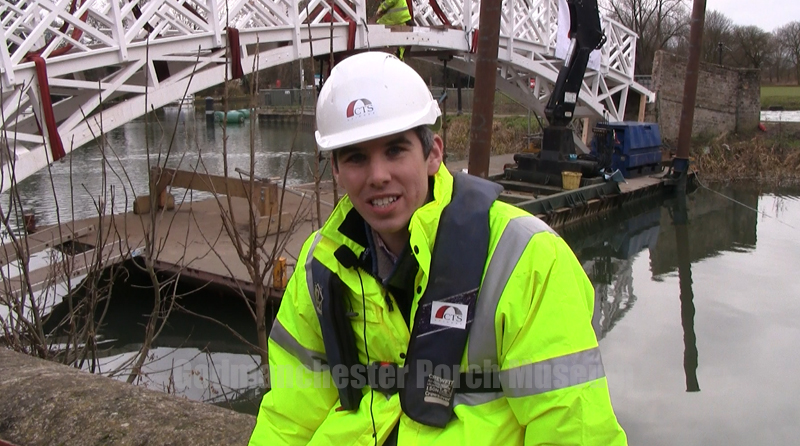 fabricated it in our factory in West Yorkshire. What you see behind us now is the culmination of the last two days of installation work but prior to that we've been working on the bridge since last summer when I came down here and took dimensions of all the abutments.
fabricated it in our factory in West Yorkshire. What you see behind us now is the culmination of the last two days of installation work but prior to that we've been working on the bridge since last summer when I came down here and took dimensions of all the abutments.
I'm looking relatively relaxed now because we've successfully installed it in between the two abutments which are a fixed distance apart. It was quiet a tricky one to measure because there are 4 points of contact on each abutment and there's a lot of things to get true and lined up. But as you can see its worked very well and we thought we were going to have to do a bit of jiggery pokery and install the second half once, take it out, remeasure, cut some off, put it back, but in fact we've actually just put it in first time and it slotted into place.
And what you see behind me now is just the final adjustments to make sure we've got direct bearing at the centre of the arch. And latter this afternoon we're going to be shimming, or we've already shimmed the base plates and we just going to be grouting up the pockets were the arch disappears into the wall and that will set it firm into the abutments.
Tomorrow we're going to come back and start the rest of the work on the bridge, there's still about another 3 or 4 days work to do we think. Were going to install the missing parts of the parapet the centre of the bridge and at the abutments and fit the top rail for twehe hand rail and there's also some diagonal raking members which need to come out of the abutments which should hopefully reduce how much it wobbles and make it into a stable structure.
So this bridge is a faithful reproduction of the bridge that was already there, but in design terms we had to start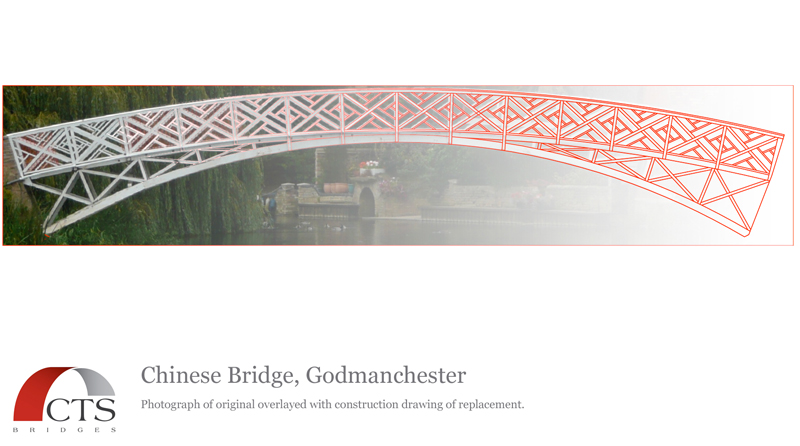 from scratch as though it was a new bridge and justify it to modern loading standard's and modern codes of practice. So underneath what you see there are a few subtle tweaks to the fixings and the way we have connected it together which should make it stronger and more robust in service. But effectively it was designed from scratch as a new structure. The biggest thing we increased the strength of was the hand rail which was woefully undersized for the task but now should be a lot more robust. The bridge itself is a complete replica of what was already there, so we had to use all the same materials.
from scratch as though it was a new bridge and justify it to modern loading standard's and modern codes of practice. So underneath what you see there are a few subtle tweaks to the fixings and the way we have connected it together which should make it stronger and more robust in service. But effectively it was designed from scratch as a new structure. The biggest thing we increased the strength of was the hand rail which was woefully undersized for the task but now should be a lot more robust. The bridge itself is a complete replica of what was already there, so we had to use all the same materials.
The structure is actually a mixture of woods. The lower arches which are doing most of the work are made out of tropical hardwood called Green heart which is very very strong and very durable used a lot in the marine industry. All of the rest of the structure below deck level is Oak. The bridge is made of exactly the same materials as the bridge we've just taken down last week. So its a mixture of woods, the lower arches which are doing most of the work are made out of a tropical hardwood called Green heart, which is just about as strong and durable as you can get in timber.
As I say they're are the most highly stressed members in the bridge carrying pretty much all the load of the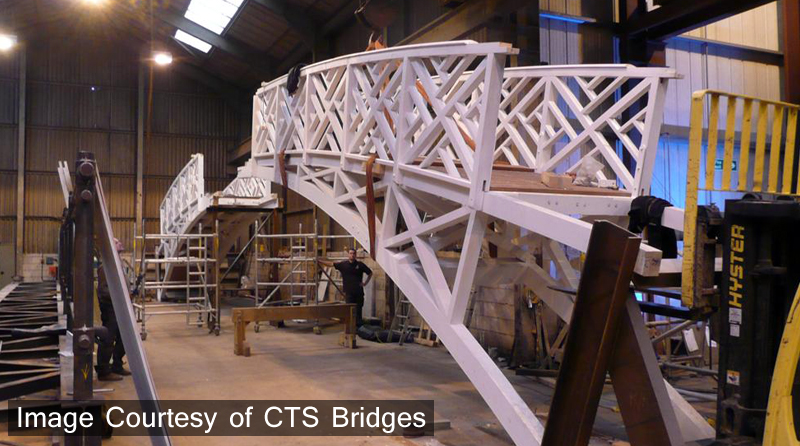 structure and above that what you see is cross bracing which isn't really doing a great deal other than supporting the deck at a higher level to meet the abutments and all those cross bracing are Oak. Above that the parapet is a mixture of hard woods and the infill parts are soft woods. We've changed the deck slightly, we were allowed to change the deck, so the deck planks are uprated and have more grip on them for pedestrians. In terms of weight both halves of the bridge weighed about three tonnes and we've installed it in a two stage process.
structure and above that what you see is cross bracing which isn't really doing a great deal other than supporting the deck at a higher level to meet the abutments and all those cross bracing are Oak. Above that the parapet is a mixture of hard woods and the infill parts are soft woods. We've changed the deck slightly, we were allowed to change the deck, so the deck planks are uprated and have more grip on them for pedestrians. In terms of weight both halves of the bridge weighed about three tonnes and we've installed it in a two stage process.
Yesterdays tasks were to get the first half in line it up and measure it. We then took it down and the second day today we've put the next half in and as you can see it fits. Because of the way the new bridge has to fit i.e. it needs to fit very tight against the existing abutments, it wasn't possible to install the bridge as a single piece so we had to bring it in in two parts. And to do that we've used effectively two small cranes one on the floating barge and another one lorry mounted on the back of a vehicle by the side of me and that's given us quiet a lot of control to make sure two halves of the bridge line up. But as I say it was not possible to install it in one big piece.
For me this was quite an important project because although our company is based in Yorkshire,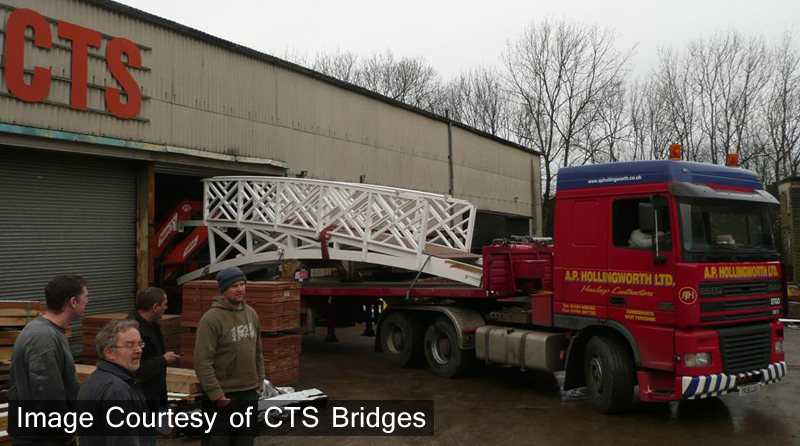 I actually grew up just up stream in Little Paxton and frequently used to canoe under this bridge during my school days. So for me its got great poignancy in it. Its good to be back in Cambridgeshire doing such a well known local landmark.
I actually grew up just up stream in Little Paxton and frequently used to canoe under this bridge during my school days. So for me its got great poignancy in it. Its good to be back in Cambridgeshire doing such a well known local landmark.






